
When contacting us by e-mail, correspondents are asked to include their name and full postal address and, when providing information, to quote exact book and magazine sources. The word ‘chess’ needs to appear in the subject-line or in the message itself.
| First column | << previous | Archives [20] | next >> | Current column |
Further to C.N. 4203, below is part of a letter to us dated 26 July 1977 from D.J. Morgan concerning his meeting with Alekhine:
‘A happy memory comes to mind.
After returning from the First War I belonged to the Liverpool C.C. Somewhere early in the 1920s A. came round to give a blindfold exhibition. I was one of the ten victims. Following the show three of us went back with him to his little hotel (The Angel, Dale St., I remember). We saw the dawn of the next day.
I happen to ask where I went wrong.
“Ah. Board 8, you played 21 B-B4. No! No!! Kt-Kt5 eh?”
I had no idea; from memory!
In a tin box under his iron bedstead he had the MS of his “Best Games”.
A powerful, pleasant personality.’
That admirable book Alexander Alekhine’s Chess Games, 1902-1946 by Leonard M. Skinner and Robert G.P. Verhoeven (Jefferson, 1998) lists, on page 770, only one exhibition (not blindfold) by Alekhine in Liverpool. It was on 29 September 1923, he scored +24 –1 =6, and one of the victories was over E. Spencer (see game one in Alekhine’s book Auf dem Wege zur Weltmeisterschaft). Can any reader in the Liverpool area kindly do a little hunting in local records to trace the blindfold display?

This picture appeared at the front of a souvenir issue of The Gambit, June 1930. The caption reads:
‘The late John Griswold White. Portrait by Sandor Vago. Painted for the White Collection.’
A colour version may be viewed at the Cleveland Public Library website.
From a review by J.M. Aitken of Réti’s Best Games of Chess by Harry Golombek (London, 1954) on pages 100-101 of the March 1955 BCM:
‘Chess books (and, in particular perhaps, games collections) can be divided into two main classes – those that are the product of a genuine devotion of the author to the subject and those that are, in the main, made to order to meet a real or supposed topical demand. It is not intended to scorn or disparage unduly the second class; given a competent and conscientious author, an excellent book will probably be produced. Nonetheless, it is in the first category that the true masterpieces are likely to be found and it is high in this class that we must rate Golombek’s book on Réti. Réti has clearly always been one of Golombek’s chess heroes and now, like a more fortunate Antony, he comes not to bury Réti, but to praise him.’
Below is Golombek’s inscription in one of our copies of his book:
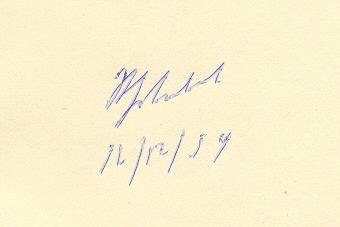
The latest addition to our feature articles listed on the Archives page is entitled ‘Immortal but Unknown’.
Our thread began with the question, ‘Which chess masters have been depicted in silhouette form?’ but has occasionally strayed into the more general field of chess-related silhouettes. Although we therefore do not plan to reproduce all possible specimens, below, courtesy of Jonathan Hinton (East Horsley, England), is the front cover of the book Chess Panorama by William Lombardy and David Daniels (Radnor, 1975):
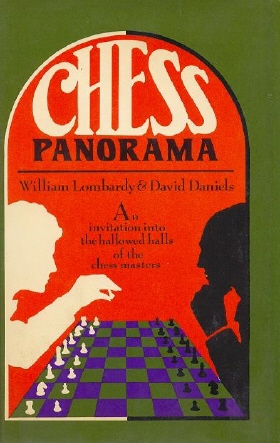
An excellent find by Michael Clapham (Ipswich, England) can be presented here, but first, to give the context, we reproduce in full C.N. 3741:
Page 67 of Modern Chess Analysis by Robin Smith (London, 2004) ascribes the following quote to Capablanca:
‘Chess books should be used as we use glasses: to assist the sight, although some players make use of them as if they thought they conferred sight.’
As indicated in C.N.s 325 and 3160, we believe this to be an old misattribution resulting from the lay-out of pages 112-113 of The Bright Side of Chess by Irving Chernev (Philadelphia, 1948):
The intermediate quote beginning ‘A recorded game ...’ is also at variance with Capablanca’s prose style, and it would hardly be logical to regard Philidor as the originator of the skittles quote or Marshall as the writer of the Paulsen anecdote. But can readers help us put this matter beyond all doubt? Certainly we have no recollection of the glasses quote in any of the Cuban’s writings, but had it appeared in print before Chernev’s book was published (in, for instance, an article by Chernev)? And who first conferred the quote upon Capablanca? As regards that last question, the earliest instance known to us is page 85 of Championship Chess and Checkers For All by Larry Evans and Tom Wiswell (New York, 1953).
Mr Clapham has now discovered the following on page 139 of The Chess-Player’s Annual for the Year 1856 edited by Charles Tomlinson (London, 1856):
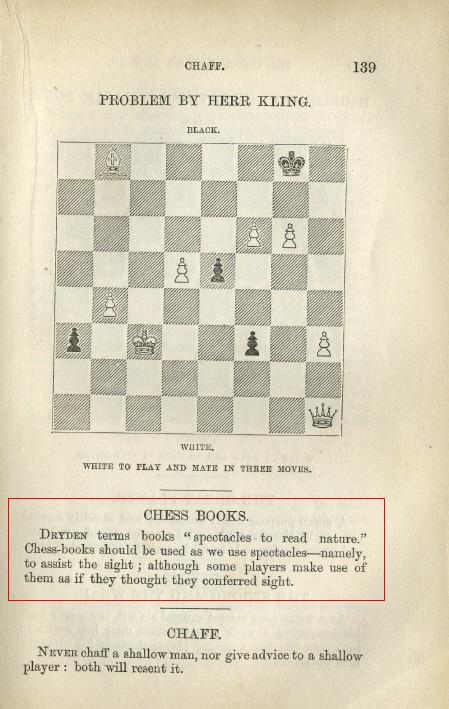
Our correspondent points out that the ‘Classified Contents’ (page ix) list this remark in the section ‘Chess Aphorisms, by the Editor’.
From Leonard M. Skinner (Cowbridge, Wales):
‘I came across a rather puzzling statement in David Bronstein’s book 200 Open Games (London, 1974). On page 16, in the preamble to a demonstration game (a King’s Gambit Accepted) against Petrosian, Tbilisi, 1963, Bronstein writes:
“As commander of the attacking army I chose as our subject one of the variations I had analysed in the well-known Keres attack and which I had once tested out on Alekhine himself.”
The suggestion that Bronstein (born in 1924) played the variation against Alekhine is not really credible. Can you throw any further light on the statement?’
It would appear to be a translation error. The text on page 22 of the Russian edition (Moscow, 1970) refers to a line of play which Keres, not Bronstein, played against Alekhine:

It may be recalled that Keres v Alekhine, Salzburg, 18 June 1942 began 1 e4 e5 2 f4 exf4 3 Nf3 Nf6 4 e5 Nh5 5 Qe2 Be7 6 d4 O-O 7 g4 fxg3.
Avital Pilpel (Haifa, Israel) writes:
‘In the April 1978 issue of Shachmat, the Israeli Chess Federation’s journal, the regular history column (“from the past”) contains (pages 105-106) an article by Shlomo Kandelsheen, an Israeli chess journalist, player, and historian, about the chess writer Menachem Marmorosh (born 1903).
Kandelsheen notes that Marmorosh “received him enthusiastically”, that their talk “lasted for many hours”, and that Marmorosh’s apartment was full of biographical and chess material which would “make every historian jump”. Kandelsheen, whom I know personally, is a serious chess historian who has written a few small but high-quality biographies of Israeli chess players.
Among other interesting material Kandelsheen writes about what is probably a unique event in modern times: a Jewish player contesting (and winning) chess games against an Arab king. The monarch in question was Abdullah I (1882-1951), and here is Kandelsheen’s description, in my translation and with my comments in square brackets:
“In 1928 Marmorosh’s fame as a strong player reached the Hashemite King Abdullah, the founder of Jordan and grandfather of Hussein, who was himself an enthusiastic chess fan and considered himself a strong player [i.e. King Hussein of Jordan at the time Kandelsheen was writing, in 1978]. In passover [1928] Marmorosh received a formal invitation to a chess match in his palace.
It was ‘an offer you can’t refuse’, and Marmorosh went to the contest as a formal guest of the Hashemite crown. [From an interview with S. Smiltiner and other sources, I know that he was driven in one of the King’s limousines from his home in Tel Aviv to Amman in Jordan, the capital.] He was received with honours, and the special guard that followed him included three ministers. On the eve of the match a crowd of spectators came to see him, including old men who said in admiration and envy: ‘We’re 80 and never saw the King personally; you’re 25 and already do so.’ Additional advice was received from one of the court advisers, who told him politely to play wisely and not to hurt the King’s prestige.
Abdullah appeared at the game, which took place in the royal tent, as a real warrior, wearing a diamond-studded sword. He smiled, shook Marmorosh’s hand, and the game began. After a few moves Marmorosh knew he could win [all of the games] easily, but out of respect for the King (...and fear) he decided to let the King win some as well. However, to avoid this being noted he decided to end one game in a draw and then lose two. In the first two games Marmorosh won, the third ended in a draw, and in the fourth his position was completely lost. Abdullah, who was a clever man and felt that the Jew was letting him win, looked at Marmorosh with a questioning glance and said, ‘enough with the blunders’, and Marmorosh was forced to win the game from the lost position. The games took a week, to the satisfaction of the King, who was happy to have played with an excellent chessplayer, whom he nicknamed ‘Capablanca’.
When Marmorosh left, the King gave a banquet in his honour in the best tradition of Arab hospitality, and said: ‘My home is open to you at any time’.”
Almog Burstein, an Israeli chess official, has told me that he has seen in the Chess Club of Amman a picture of the two playing chess. The question is: do any game-scores exist?’
From Richard Benjamin (Marietta, GA, USA):
‘I have been collecting chess postcards, stamps and memorabilia for many years and have one of the world’s largest collections of chess postcards. Since I hope to write a book on the subject, I should like to hear from any readers with interesting items, such as the silhouette postcards of Mr Calle Erlandsson which were reproduced in C.N. 4180.’
We shall forward to Mr Benjamin any replies received, and in the meantime he has made available for presentation here two postcards from his collection. The first is of Reshevsky, and the second was sent by Dawid Przepiórka during Győr, 1924:
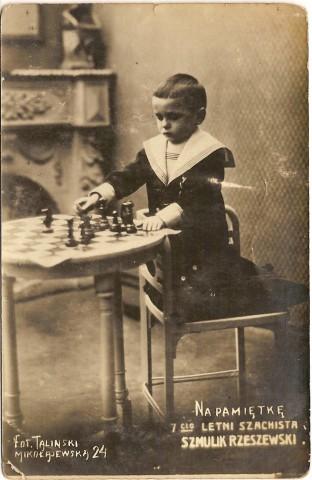

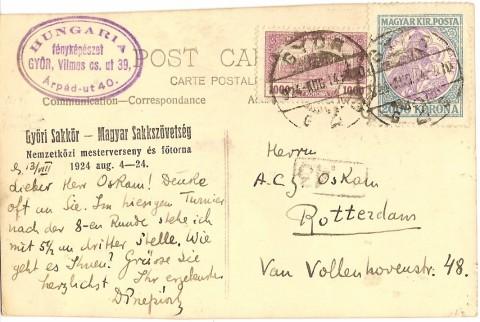
A sidelight following on from the Capablanca/spectacles matter in C.N. 4209: the earliest illustration we recall seeing of the Cuban wearing glasses is a sketch in the Budapest, 1928 tournament book.
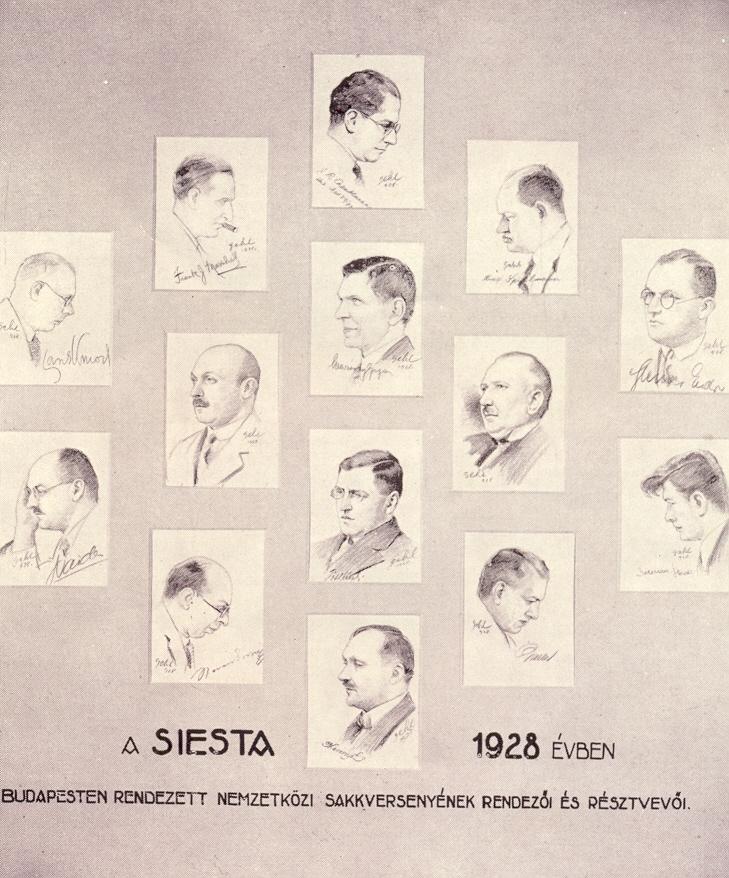
A 1966 photograph of Charousek’s resting place in Nagytétény, with a new tombstone and J. Hajtun, A. Földeák, R. Sallay, A. Vajda and G. Barcza in attendance, was published on the final page of volume three of Magyar Sakktörténet by Barcza and Földeák (Budapest, 1989). See also page 229 of Chess Comet Charousek by Victor A. Charuchin (Unterhaching, 1997).
From an editorial on page 1 of the February 1875 issue of the City of London Chess Magazine:
‘The traveller in foreign parts, when he sees a chessboard anywhere, feels himself to be amongst friends, and instantly challenges someone to a contest without thinking of pulling out his letters of introduction. The confusion produced by the masons of Babel ceases when two chessplayers meet; they may not be able to speak to each other orally, but the moves are a common language, and a checkmate requires no interpreter.’
Rob Bijpost (Middenmeer, the Netherlands) informs us that the Dutch chess collectors’ society Motiefgroep Schaken is searching for graves with a chess motif:
‘So far, we have found 30 specimens of well-identified graves, such as those of Alekhine, Nimzowitsch, Staunton, Steinitz and Tarrasch, but we are particularly interested in elegant chess motifs, and not only the graves of well-known players.’
Page 176 of A Chess Omnibus reproduced from page 48 of Chess Pie, 1922 a photograph of the problemist Antonio Bottacchi (1900-1969) which, we suggested, bore quite a resemblance to Capablanca:

Michael McDowell (Westcliff-on-sea, England) points out that there was a small photograph of Bottacchi in the ‘Good Companion Chess Board No. 2’ in The Good Companion Two-Mover by G. Hume and A.C. White (Stroud, 1922). Our correspondent also writes:
‘In September 2005 the Italian problemist Oscar Bonivento published a collection of Bottacchi’s problems, Realismo e Romanticismo nell’arte problemistica di Antonio Bottacchi in 432
problemi commentati. It contains four photographs of him. Two of them confirm a certain resemblance between the young Bottacchi and the young Capablanca, although this disappeared over time as the former became rather portly.’
Also on the subject of Capablanca, C.N. 1418 quoted the following from page 157 of the November 1933 American Chess Bulletin:
‘Fritz Haller, one of the younger generation of Swiss chess experts and a participant in class A at the congress in Berne, is said to bear a striking resemblance to José R. Capablanca when the latter was younger. Haller was born on 16 August 1910.’
C.N. 1442 reported that Fritz (Friedrich) Haller had sent us two photographs of himself. In a letter dated 10 June 1987 he commented to us:
‘Personally I have never considered there to be any resemblance between Capablanca and me, but you must judge for yourself.’

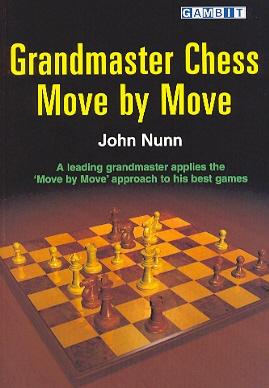
The back cover of Grandmaster Chess Move by Move by John Nunn (London, 2005) describes him as ‘arguably the most highly acclaimed chess writer in the world’, and here we offer some reflections on certain aspects of his output and on how he differs from most chess authors.
A polymath, Nunn has written authoritative monographs on openings, endings and compositions, as well as annotated games collections and autobiographical volumes. As an annotator he is equally at home presenting lucid prose descriptions for the relative novice and analysis of extreme depth for the expert. He has also penned a fair amount of topical commentary and discussion material, though this has seldom appeared in book form. In 2003 he retired from tournament play, and the Introduction to Grandmaster Chess Move by Move (page 6) describes it as ‘a final volume on the last part of my career’.
Fortunately, his writing career continues apace. For the subject matter of his books he is notably disinclined to take the low road. Not for him the production of an instant match-book or a quick throw-together on whichever master is the biggest box-office draw of the day. One indulgence is to lure with the frequent use of ‘secrets’ in his book titles: Secrets of Grandmaster Play, Secrets of Grandmaster Chess, Secrets of Practical Chess, Secrets of Rook Endings, etc. Although he is a fine teacher, writing straightforward prose without effets de style, a few of his books may be too detailed for any but the most dedicated student, yet even chess enthusiasts who will never peruse, or open, the 320-page tome Secrets of Pawnless Endings (1994) should find it gratifying that a work of such quality exists.
Having no interest in endlessly, or even occasionally, trotting out Morphy v the Duke and Count (‘not an especially good game’, he wrote on page 4 of Learn Chess), Nunn is the antithesis of those chess hacks who survive, more or less, on a diet of low-hanging fruit. Chess books are littered with factual errors thoughtlessly copied from author to author, but copying is not in Nunn’s nature, and his desire not to err is particularly pronounced. Every writer makes mistakes, of course, but not every writer makes an effort to avoid doing so. Few writers take such pains as does Nunn to reduce the risk of error to a minimum.
Intelligence, decency and perfectionism are hallmarks of Nunn, and his views on the average sludge of journalism, which is devoid of all three hallmarks, are hard to dispute. ‘Jimmy Nunn’ was the rendition of his name in a newspaper as far back as 1966, and on page 12 of Secrets of Grandmaster Chess he commented, ‘My opinion of the accuracy of journalists took a nose-dive and has been going down ever since’.
Given Nunn’s versatility in his book production, it may seem paradoxical to attribute to him a strong sense of self-restraint and the ability to rein himself in, yet we consider these to be key factors in his success. His range is vast, but he does not regard his accumulation of talents as a passe-partout for use throughout the entire realm of chess literature. His incursions into chess history, for instance, are relatively rare, but when he does wade in (a notable example being the ‘test of time’ chapter in John Nunn’s Chess Puzzle Book, which scrutinized the quality of play at Carlsbad, 1911) the terrain is selected with care, he ensures that he is briefed to the gills, and the result is something fresh.
The high standards which Nunn demands of himself have been reflected too in his cautious approach to annotating the games of other masters, for even here, on what may be regarded as his home ground, he does not want to let his readers, or himself, down. Below is part of a contribution he made in 1985 to C.N. 993:
‘When I was younger, my games were occasionally annotated in magazines by other players. I was astonished to see what they wrote; indeed, on some occasions, I could scarcely believe that it was the same game. When I started annotating games myself I began to see how difficult it is to write about other players’ games. Of course, one can restrict oneself to essentially trivial comments, or fall back on the usual clichés, but really to penetrate the reasoning of another player is very hard. It is correspondingly valuable when one does gain a fresh insight by analysing games, but this requires a great deal of time which is not always available.’
Yet Nunn is not staid or unadventurous. Without courting controversy, he has no qualms about speaking his mind. As long ago as 1991 he was deploring ‘The Decline of British Chess’ (on pages 20-23 of the January 1991 BCM). His article prompted exchanges in that publication (March 1991, pages 114-115 and April 1991, page 171) and brought him a hands-down victory (against, it must be said, feeble opposition). Now, an essay in Grandmaster Chess Move by Move (pages 270-277) entitled ‘The State of the Chess World’ finds Nunn casting his net more widely, with, inter alia, deft but pointed strictures about the World Chess Federation which are infinitely more potent than any amount of the more customary anti-FIDE squawking.
When in possession of a rock-solid case, he does what any truthful author is glad to do: dire tout haut ce que les autres pensent tout bas. Few, if any, Batsford authors in the early 1990s were prepared to criticize publicly (as Nunn did, on pages 26-27 of the German publication ChessBase Magazin, July-August 1991) the lamentable Batsford Chess Encyclopedia, a would-be flagship which capsized the moment it left the slipway. Nunn’s article on ‘Chess Publishing and the Batsford Story’ on pages 278-285 of Grandmaster Chess Move by Move provides a further grisly reminder of what B.T. Batsford Ltd. was like for much of the 1980s and the early 1990s. Even today, such insiders’ stories are a rarity, but Nunn has the facts and is prepared to share them.
Naturally enough for someone who is ‘arguably the most highly acclaimed chess writer in the world’, in most of Nunn’s books he stands as the sole author. Where he has worked on somebody else’s book, for the production of an algebraic edition (an exercise involving more pitfalls than might be thought), the outcome has not always been happy. The most regrettable case, the My 60 Memorable Games débâcle in the mid-1990s, was by no means his sole responsibility but it entailed uncharacteristic lapses of judgment, both pre- and post-publication. When describing in Grandmaster Chess Move by Move a string of inglorious Batsford doings, Nunn had a golden opportunity (or, indeed, a golden obligation) to include a belated word of contrition about the Fischer episode, and it is inexpressibly disappointing that, a decade on, he still felt unable to do so, passing over the aberration in silence.
Given Nunn’s propensity for keeping a firm hand on the controls, it is no surprise that nowadays he writes and produces books for his own company, Gambit Publications Ltd. Despite a certain sameness in many Gambit books (if a dozen of them were randomly opened on a table, could even the Gambit editorial team identify who had written which?), the company has justly built up a reputation for quality which no British chess publisher has enjoyed since the heyday of G. Bell and Sons.
Nunn’s contribution to chess literature continues but has already been immense. Some writers create order and help chess knowledge to advance; others create disorder and obstruct such progress. In the former category Nunn is pre-eminent, and perhaps uniquely so.
What is the literary connection between these two figures?

Alan McGowan (Waterloo, Canada) offers some jottings on Gerald Abrahams at Bad Gastein, 1948:
‘Pages 325-326 of the September 1948 BCM have the game Danielsson (misspelt “Danielson”) v Abrahams played at Bad Gastein, 1948: 1 Nf3 f5 2 g3 Nf6 3 Bg2 c6 4 O-O d6 5 d4 Qc7 6 c4 e5 7 Nc3 Be7 8 dxe5 dxe5 9 e4 O-O 10 exf5 Bxf5 11 Qe2 Nbd7 12 Re1 Rae8 13 Bg5 h6 14 Bxf6 Bxf6 15 Ne4 Bxe4 16 Qxe4 Nc5 17 Qc2 e4 18 Nd2 Bd4 19 Re2 e3 20 Nf3 exf2+ 21 Kf1 Be3 22 b4 Na6 23 Qb3 Qe7 24 Rd1 Qe6 25 a3 c5 26 b5 Nc7 27 g4 Qe4 28 Rd3
28...Rxf3 29 Bxf3 Qxf3 30 Rexe3 Qh1+ 31 Kxf2 Ne6 32 Qd1 Qxh2+ 33 Ke1 Rf8 34 Rf3 (The ChessBase Megabase has a different move order: 32...Rf8 33 Rf3 Qxh2+ 34 Ke1.) 34...Nf4 35 Rxf4 Re8+ 36 Kf1 Qxf4+ 37 Kg1 Re4 38 Rd8+ Kh7 39 Qd3 Qxg4+ 40 Kh1 Qh5+ 41 Kg2 Qg6+ 42 Kf3 Qf5+ 43 Kg3 Rg4+ 44 Kh3 Qxd3+ 45 Rxd3 Rxc4 46 Rd7 Rc3+ 47 Kh4 Rxa3 48 Rxb7 c4 49 Kh5 c3 50 Rc7 Ra4 51 b6 c2 52 b7 c1(Q) 53 White resigns.
When I first came across this game, many years ago, I was struck by the opening moves employed by that brilliant (and sometimes erratic) player Gerald Abrahams. The formation he uses in the Dutch Defence is usually referred to as the Hort-Antoshin Variation, which I think was introduced by Hort around 1960, with Antoshin later contributing to the underlying ideas.
Described as “an extremely interesting game”, it was annotated in the Games Department of the BCM, conducted by C.H.O’D. Alexander, with the following remark after move 27:
“Abrahams plays the ending somewhat maliciously, holding out tempting hopes of stalemate to his opponent only to disappoint him unkindly at the end.”
There are two other games by Abrahams from Bad Gastein in the 1948 BCM volume, against Canal and Tóth. Both are wonderful examples of his sharp style, and page 288 of the August issue stated that the game against Tóth earned Abrahams a brilliancy prize. However, on page 259 of Not Only Chess (London, 1974) and page 137 of Brilliance in Chess (London, 1977) Abrahams himself wrote:
“The Bad Gastein organizers promised me a brilliancy prize for this, but all I got was a free copy of the tournament book.”’
This illustration appeared on page 60 of A Book of Chess by C.H.O’D. Alexander (London, 1973):
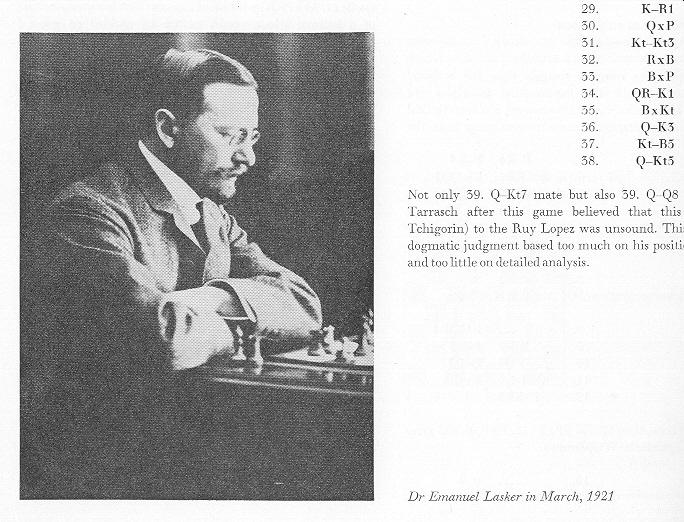
In reality, both parts of the caption (‘Dr Emanuel Lasker’ and ‘in March, 1921’ are wrong. As noted on page 315 of A Chess Omnibus, the player is Tarrasch. We add here that the photograph was the frontispiece of Schachjahrbuch für 1908 by L. Bachmann (Ansbach, 1909), whose caption correctly identified the two masters and noted that the picture had been taken in Munich during their 1908 world championship match.


From an 1839 paper about Deschapelles by George Walker – see page 38 of his book Chess & Chess-Players (London, 1850):
‘The sceptre of chess, in Europe, has been for the last century, at least, wielded by a Gallic dynasty. It has passed from Legalle to La Bourdonnais, through the grasp, successively, of Philidor, Bernard, Carlier and Deschapelles.’
What are the best sources for biographical information about the forgotten players Bernard and Carlier?
A further word on C.H.O’D. Alexander’s fine work A Book of
Chess (London, 1973) concerns the back-cover illustration
of ‘Master Walter Wisbey (aged 8) playing Mr T. Whiltard (aged 91)
in 1913’. The venue was given as Cheltenham (England) when the
picture appeared on page 124 of Schach by R. Finkenzeller,
W. Ziehr and E.M. Bührer (Aarau, Stuttgart, 1989). The photograph,
credited to the Radio Times (later: BBC) Hulton Picture Library,
is now owned by Getty Images and may be viewed by entering
hk3649-001 on the search
page. White’s name is given there as Wisby.
We should welcome information about both players.

C.N.s 2581 and 3820 asked if anyone in this picture could be identified. All that can usefully be added at present is that the Getty Images site lists it (53272251) as ‘United States circa 1950s’ and names the photographer as George Marks.
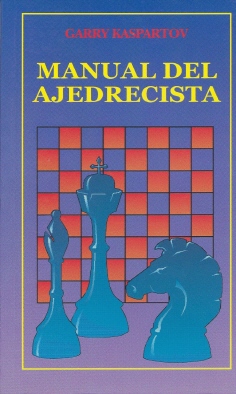
Examining the book for possible clues, we note that the only master game presented is the following:
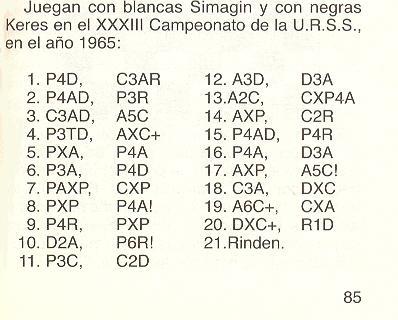
However, this victory by Keres in the 1965 USSR Championship was against Kuzmin, not Simagin. Have any other books made the same mistake?
The fact that a volume has appeared with authorship ascribed to ‘Garry Kaspartov’ seems to have aroused little interest or concern. Would the same equanimity exist if a Spanish publisher brought out a chess book which named the author as ‘Bobby Fischter’?
Jerry Spinrad (Nashville, TN, USA) points out that two rare terms, ‘conversation game’ (consultation game) and ‘masque game’ (living chess), occurred in a passage in The Albion, 19 March 1870:
‘There will shortly commence a conversation game between some New York players and members of the Williamsburgh Club. It has also been announced that the last-mentioned Club will give a masque game upon a ball-room floor, in which ladies and gentlemen, appropriately dressed, will represent chess pieces – kings, queens, knights, bishops, castles and pawns – and that their movements will be directed, as in the common game, by two noted players.’
The following helpmate in three moves by G. Páros was published on page 14 of The Book of Extraordinary Chess Problems by Stephen Addison (Ramsbury, 1989):
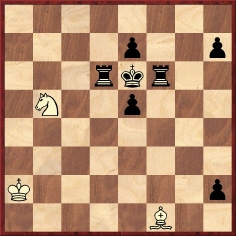
On pages 68-69 the author gave the solution as follows:
‘This prize-winning composition exemplifies the usual helpmate practice of Black using his pieces to block and occupy the escape squares of his king.
1 h1(B) Bd3 2 Bc6 Bg6 3 Bd7 Nc7.’
Michael McDowell (Westcliff-on-sea, England) comments:
‘This does a disservice to a great composer, the late György Páros, by truncating one of his finest problems. The composition (First Prize, FIDE Tourney, 1958) is a twin, with the knight moving from b5 to d3, f3 and h5 in turn. The full solution reads:
a) 1 h1(B) Bd3 2 Bc6 Bg6 3 Bd7 Nc7;
b) 1 h1(Q) Bg2 2 Qh5 Be4 3 Qf7 Nc5;
c)1 h1(N) Bb5 2 Ng3 Bc6 3 Nf5 Ng5;
d) 1 h1(R) Bb5 2 Rd1 Be8 3 Rd5 Ng7.
By itself part a) is trite, but in its full glory the problem is a masterpiece. The judge, László Lindner, wrote:
“The harmony of the play and the economy of the setting deserve the highest praise.”’
A number of predictions, successful or otherwise, have been quoted over the years. Below is an extreme example of the ‘otherwise’ category, from page 334 of Shakhmatny listok, November 1925:
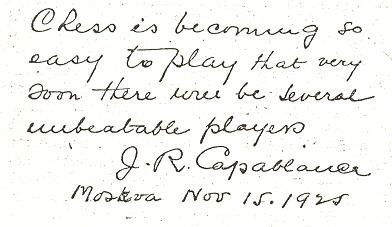
A rich collection of postcards with a chess theme can be viewed online.
Addition on 17 March 2020: The link no longer works.
On page 235 of Grandmaster Chess Move by Move (London, 2005) John Nunn gave the following position from his game against L. Keitlinghaus in the 2002/3 Bundesliga:
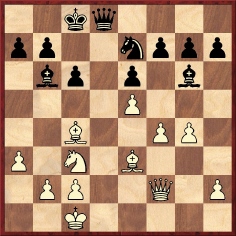
Nunn played 19 Bc5 and commented:
‘In my book Secrets of Practical Chess, I introduced the term “collinear move” to describe a move such as this, in which two opposing pieces face each other, and one slides along the line of attack without capturing the enemy piece For some reason such moves are very easy to overlook.’
In Secrets of Practical Chess (1998) it was on pages 55-57 that Nunn discussed ‘collinear moves’, noting that ‘they are even more difficult to spot when the attacked piece moves away from the attacking piece’. As an illustration he gave Tal v Fischer, Curaçao, 1962 (16...Bb5).
This position comes from page 26 of Alexander on Chess by C.H.O’D. Alexander (London, 1974):
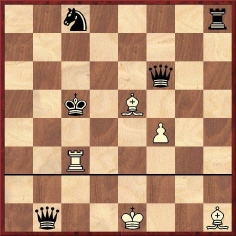
Alexander’s caption reads:
‘Three examples of the skewer. White bishop skewers R through the Q and the White rook skewers Kt through the K; Black Q skewers B through K at bottom of diagram.’
C.N. 3061 (see page 102 of Chess Facts and Fables) mentioned that Edgar Pennell coined ‘skewer’ in the late 1930s. The term is absent from the Small Chess Dictionary by Y. Averbakh (Belgrade, 1980), and translations into various languages will therefore be welcomed. In German, for example, Spiess is the rough equivalent, although it has no entry in German-language chess encyclopaedias and dictionaries. As regards Spanish, page 21 of Enciclopedia del ajedrez by H. Golombek (Barcelona, 1980) translated skewer by ataque ‘a través’ .
Another term for skewer in English (particularly in the United States) is x-ray attack. When did that make its first appearance in chess literature?

The first comprehensive biographical games collection about José Raúl Capablanca (left) was by José Antonio Gelabert (right). It was entitled Glorias del Tablero “Capablanca” (Havana, 1923), and the photographs above appeared in the slightly different second edition, published in 1924.
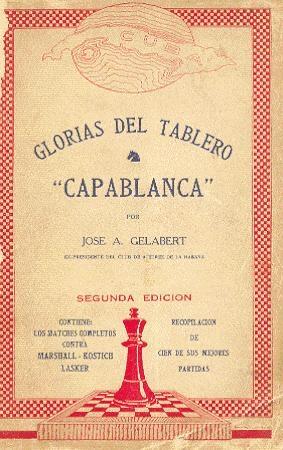
Marek Soszynski (Birmingham, England) mentions that page 70 of a book he co-authored with Jan Przewoznik, How to Think in Chess (Milford, 2001), noted John Nunn’s term ‘collinear move’, while page 234 suggested that the following example of ‘collinearity’ was possibly ‘the move of the book’:
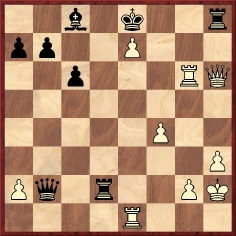
G. Maróczy v M. Romi, San Remo, 25 January 1930
White played 41 Qh5 and won.
C.N. 3958 referred to a list of alleged chessplayers ‘featuring everyone and anyone from Adolf Hitler to Enid Blyton’. Regarding the latter, a prolific British author of children’s fiction, we have come across a number of references to chess in The Mystery of the Missing Man (on pages 37, 72-73, 76, 107 and 139 of the 1965 edition published by Armada Paperbacks, London).
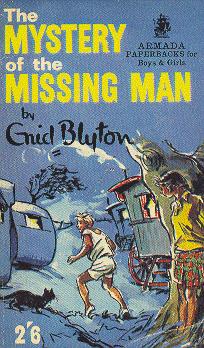
That, of course, does not make Enid Blyton a chessplayer. After quotations, the field of chess lore most fraught with imprecision seems to be catchpenny claims, made without a whit of corroboration, about celebrities’ interest in chess.
Turning to the French term for skewer, Hassan Roger Sadeghi (Lausanne, Switzerland) quotes the definition of ‘enfilade’ on page 31 of Le guide des échecs by N. Giffard and A. Biénabe (Paris, 1993):
‘Attaque, avec une pièce à longue portée, d’une pièce adverse derrière laquelle se situe, sur la même ligne d’action, une autre pièce du camp opposé. Si la première fuit, la deuxième se fait prendre. C’est tout l’intérêt de cette attaque.’
The entry for ‘enfilade’ on pages 131-132 of the Dictionnaire des échecs by F. Le Lionnais and E. Maget (Paris, 1967) limited itself to cases where check is given, commenting that ‘certaines études artistiques sont fondées sur les échecs enfilade’. The example presented by the Dictionnaire was a study by Henri 42 from page 217 of the July 1903 Deutsche Schachzeitung:
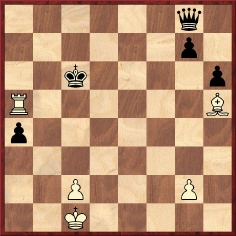
‘1 Ra8 If 1...Qxa8 2 Bf3+ enfilade; if 1...Qh7 2 Bg6 Qxg6 3 Ra6+ enfilade; if 1...Qc4 2 Rc8+ enfilade; if 1...Qa2 2 Rxa4 and if 2...Qxa4 3 Be8+ enfilade, etc.’
The solution as given on page 299 of the October 1903 Deutsche Schachzeitung was 1 Ra8 Qa2 2 Rxa4 Qg8 3 Ra8 Qh7 4 Bg6 and wins. The Dictionnaire added a white pawn on a2, but that square was empty not only in the German magazine but also when Rinck gave the study in his books, e.g. on pages 254-255 of 300 fins de partie (Barcelona, 1919). Below is the title page of our copy, inscribed by Rinck:

Pages 65-66 of the Diccionario de ajedrez by A. Gude (Madrid, 2005) use the term ‘enfilada’, adding that it is also known in Spanish as ‘ataque en línea’.
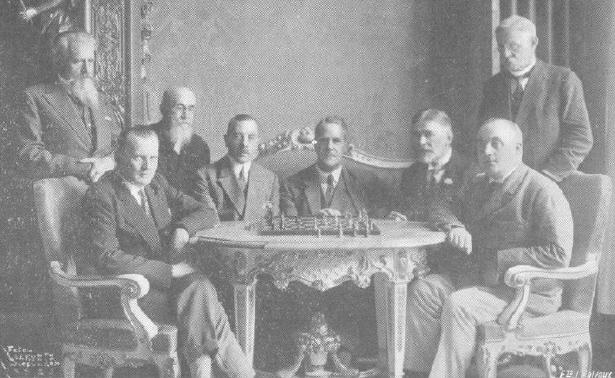
This photograph was published as a supplement to the January 1930 issue of L’Echiquier. Alexander Alekhine and Efim Bogoljubow are seated in the foreground and the FIDE President, Alexander Rueb, is in the centre. Who are the others?
The lack of clarity and precision regarding quotes is illustrated by page 151 of Schott’s Sporting Gaming & Idling Miscellany by Ben Schott (London, 2004), which has eight source-free citations on chess. At least one is simply wrong (the attribution to Lenin of the saying ‘Chess is the gymnasium of the mind’ – see C.N. 3626), and the first of the eight is attributed to Nigel Short:
‘Chess is ruthless: you’ve got to be prepared to kill people.’
That quote is also on many webpages with, mirabile dictu, what looks like a specific source: The Observer, 11 August 1991. However, we have found that the newspaper merely listed it in its ‘Sayings of the week’ (page 18), with no particulars. Chess was in the news at the time, and that same day the Short v Gelfand world championship quarter-final match began in Brussels.
Nigel Short informs us:
‘I have no recollection of having made that particular statement, although it sounds like something I might well have said in my younger days. I would guess it is probably authentic.’
Can a reader help us to find out more?
The inscribed feature below comes from the programme for the 2002 ‘Russia versus the World’ event in Moscow:

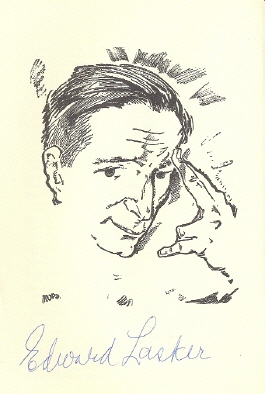
From pages 66-67 of Chess for Fun & Chess for Blood by Edward Lasker (Philadelphia, 1942):
‘[The diagram below] shows a position which I had in the first chess tournament I ever played, at the age of 18. I shall never forget it because had I made the right move I would have won the Berlin championship. I had prematurely resigned myself to losing this game because my king is held on the queen’s wing by my opponent’s passed pawn, so that he can leisurely attack my pawns with his king and queen one of his pawns on the king’s wing.
In that frame of mind I played half mechanically 1 f4 and resigned the game when Black replied ...f6, as the three black pawns hold my four pawns. If I advance my knight’s pawn Black simply walks over to the king’s wing.
Had I carefully analyzed the consequences of 1 f6!! I would have probably seen that this move wins the game. After 1...gxf6 2 f4 the threat is 3 g5, freeing the rook’s pawn, so that Black must play 2...Kd4 3 g5 fxg5 4 fxg5 Ke5 5 gxh6 Kf6. But now comes the surprise: 6 Kc2 forces Black’s king to move, and his only pawn prevents him from reaching my pawns. No matter where he moves, 7 h7 wins.’
Lasker also wrote about the position in Chess Strategy (e.g. on pages 84-85 of the London, 1915 edition), where Black was named as Moll and the occasion was given as ‘Berlin championship, 1904’. On the other hand, circa 1907 could be inferred as the date from what Lasker, who was born in December 1885, wrote on page 105 of the April 1963 Chess Review. Ossip Bernstein’s name was introduced into the account:
‘I met Bernstein in Berlin over 56 years ago when both he and I were young students. I was competing in a tournament and I had just resigned my game against the opponent leading the contest. [Here Lasker gave the above diagram and the moves 1 f4 f6.]
Then an onlooker behind my chair said to me with a smile, “Do you know that, just a move before you resigned, your opponent could have done so?” I turned to the man in surprise and was struck by his extraordinarily good looks. He was about six foot three, slim as a young tree, and very handsome with black hair, a high forehead and large shining eyes. I asked him who he was; and, when he introduced himself as Ossip Bernstein, I was overawed.
He showed me that with 1 f6! my game was won. [Lasker added the same analytical line as above.] I thanked Bernstein for this lesson, and we went out to dine together. It did not take us long to discover that we were both lovers of music, and this forged a strong bond of friendship.’
In Lasker’s similar, though brief, account of his meeting with Bernstein on page 75 of Chess Secrets I Learned from the Masters (New York, 1951) the chronology suggested that it occurred no earlier than the end of 1909 (after Lasker’s match against Erich Cohn).
So when was the game played? The answer is 1907. Below is the full score, from which it will also be seen that the endgame position given by Lasker in his books and article was incorrect. The game was published on pages 65-66 of Deutsches Wochenschach, 24 February 1907, with the heading ‘Winterturnier (1. Kl.) der Berliner Schachgesellschaft, Jan. 1907 (7 Rde)’:
Eduard [later Edward] Lasker – Kurt Moll1 d4 d5 2 c4 e6 3 Nc3 c5 4 cxd5 exd5 5 Nf3 Nc6 6 Bf4 Nf6 7 e3 Be6 8 Qb3 Nb4 9 Bb5+ Bd7 10 O-O c4 11 Qa4 a6 12 Bxd7+ Qxd7 13 Ne5 Qxa4 14 Nxa4 Nh5 15 a3 Nxf4 16 exf4 Nc6 17 Rfe1 Be7 18 Nxc4 dxc4 19 d5 b5 20 Nc3 O-O-O 21 dxc6 Bf6 22 Rad1 Rxd1 23 Rxd1 Bxc3 24 bxc3 Rd8 25 Rxd8+ Kxd8
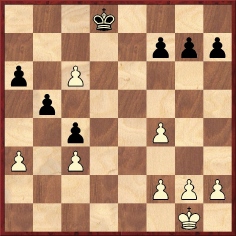
26 Kf1 Kc7 27 Ke2 Kxc6 28 g4 a5 29 h4 Kc5 30 f5 b4 31 cxb4+ axb4 32 axb4+ Kxb4 33 Kd2 Kb3 34 Kc1 Kc3 35 h5 h6

36 f4 f6 37 White resigns.
Thus Lasker’s writings inverted the position of Black’s king and pawn on c3 and c4.
The crosstable of the 15-player event was published on page 146 of the 28 April 1907 issue of Deutsches Wochenschach. Given that Lasker finished equal eighth and ninth, six points behind the winner Treybal (whereas Moll was fourth), it is unclear why he wrote regarding his game against Moll (played, as noted above, as early as round seven), ‘had I made the right move I would have won the Berlin championship’.
Kurt Moll, who was also a chess composer, died on 14 November 1915 in Russia, on the Eastern Front, as reported on pages 333 and 345 of Deutsches Wochenschach, 5 December 1915:
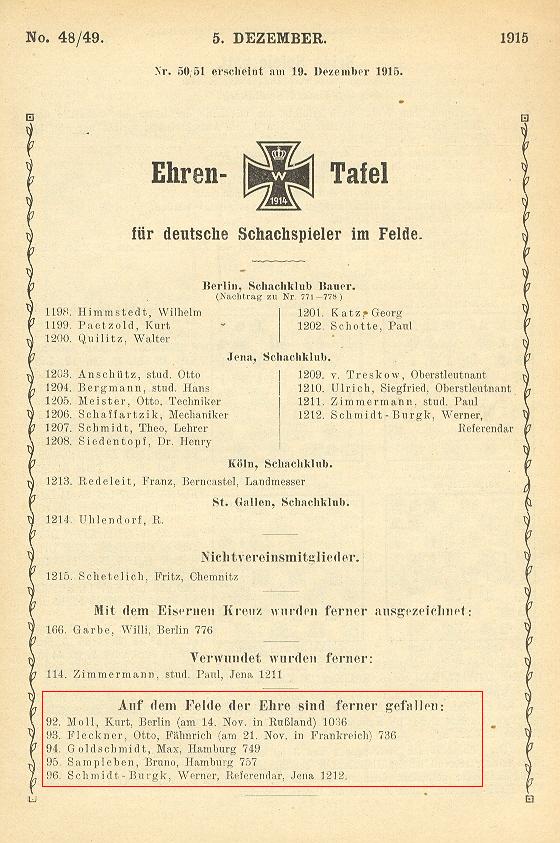
In the item on Lasker v Moll (C.N. 4239) the former’s use of the descriptive notation was converted to the algebraic. It is, though, worth recalling that, as mentioned on page 154 of A Chess Omnibus, Lasker used the algebraic notation, controversially, in Chess and Checkers The Way to Mastership (New York, 1918).
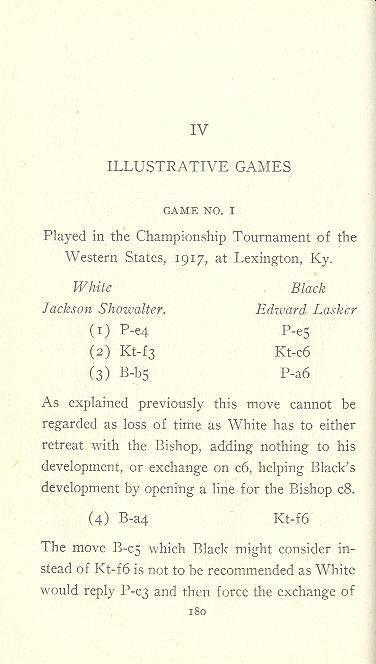
Tom Rogers (Westfield, NJ, USA) has joined in the hunt for information about Capablanca’s one-time business associate Frederick D. Rosebault and provides the photograph below of 514 Kimball Avenue, Westfield as it stands today. C.N. 3559 mentioned that Rosebault lived with his family at that address circa 1911.


This chess figure has been mentioned in recent C.N. items, but who is he?
From Lonnie Kwartler (Chester, NY, USA):
‘The player on the right struck me as Tyrone Power around 1948.’
Which is the smallest chess book ever published, in terms of page size? The record in our collection seems to be held by Sakkvilágbajnokok by Károly Molnár (Budapest, 1977), a 243-page hardback on the world champions. It measures approximately 6cm x 4cm, and for purposes of comparison we have set it alongside a CD:
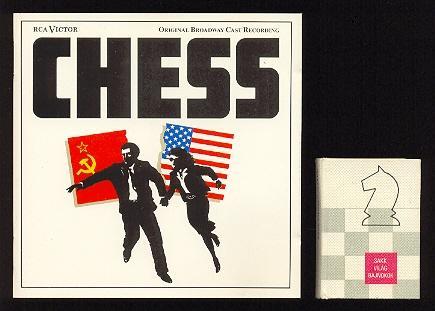
C.N. 4231 asked when ‘x-ray attack’ first appeared in chess literature. Jack O’Keefe (Ann Arbor, MI, USA) writes:
‘The term “x-ray attack” was apparently originated by Kenneth Harkness. On page 25 of the April 1947 Chess Review, in his series “Picture Guide to Chess”, he mentioned forks and then wrote:
“There is another type of double attack in which the targets are threatened in one direction. The attacking piece threatens two units, one behind the other, on the same rank, file or diagonal. This double threat has lacked a good descriptive name. We suggest ‘X-Ray’ attack.”’
The article by Harkness (pages 25-30) gave many illustrative positions and used the term x-ray countless times.
Walter B. Hart (Burra Creek, Australia) enquires about what became of Pillsbury’s wife.
‘We know from Nick Pope (Harry Nelson Pillsbury American Chess Champion), John Hilbert (Napier The Forgotten Chessmaster) and others that Harry Pillsbury married Mary Ellen Bush on 17 January 1901. Apparently he was engaged to her for some three years before their marriage and met her at one of his chess exhibitions. Other than that, not much seems to be known about Mrs Pillsbury or her fate after Pillsbury’s early death in 1906.
In the group photograph taken at Hanover, 1902 there is a female sitting next to what looks like Pillsbury. The couple were touring Europe at that time; is there any chance that this is indeed the elusive Mrs Pillsbury?
It is reported that she was the daughter of Judge Bush of Monticello, NY and the aunt of W.E. Napier’s wife Florence (née Gillespie), Florence’s mother being Mary Ellen’s elder sister, Henrietta.’
We offer a few observations:
1) The references are pages 37-38 of the Pillsbury book (which quotes Louis Uedemann in the Chicago Tribune of 20 January 1901) and page 329 of the Napier volume. The Uedemann report also appeared on page 5 of Checkmate, January 1901.
2) Below is the relevant part of the Hanover, 1902 group photograph, i.e. a detail from the front cover of the dust-jacket of the 1983 Olms reprint of the tournament book:
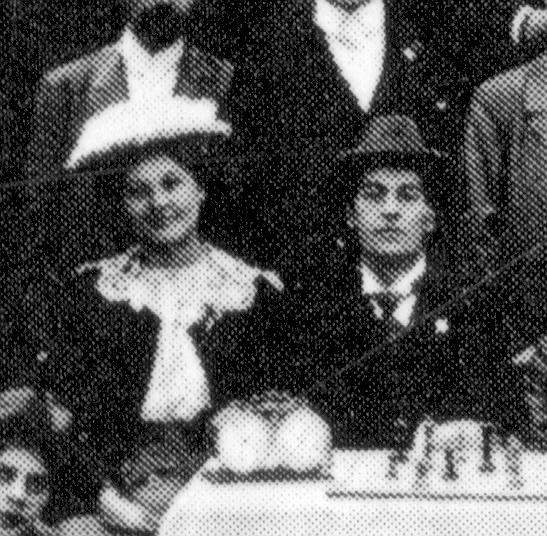
3) Some further details appeared on pages 101-102 of the March 1901 BCM. The wedding took place ‘at the home of Mr Bush, a brother of the bride’, and her father was described as follows:
‘... the late Albert J. Bush, who at his death was judge of the County Court, Sullivan County, New York, and resided at Monticello. Judge Bush was considered the ablest lawyer in Sullivan County, and up to the date of his death was respected by all throughout the community in which he resided alike for his ability and integrity of purpose. His daughter was born at Monticello, and resided there with her mother several years after the death of her father. She and Mr Pillsbury have been friends for many years. Prior to her marriage Mrs Pillsbury spent some time in Philadelphia with friends of her family, and during that time many of Mr Pillsbury’s friends had the pleasure of meeting her. All were charmed not only with Mrs Pillsbury’s beauty but with her unusually bright mental attainments ...’
4) We recall seeing no post-1906 information about her.
Following on from C.N. 4246, our correspondent in Australia, Walter B. Hart, writes:
‘Pillsbury’s gravestone (in four-sided obelisk form) can be viewed at the ‘Find A Grave’ website. Only two sides are visible in the photograph supplied, with one side inscribed Harry N. Pillsbury 1872-1906 and the other with three names and dates which seem to read: Edwin B. Pillsbury 1860?-1941; his wife M. Eva 1865?-1937; and May F. Pillsbury 1870-1941.’
The pencil sketch of Pillsbury below was drawn by Mrs G.A. Anderson in 1898 and was published on page 66 of Chess Pie, 1922:
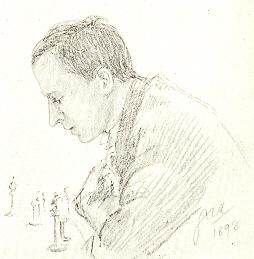
Further to the investigation into the Nimzowitsch ‘Crown Prince’ affair (see pages 293-295 of Chess Facts and Fables), we now note the following early occurrence of the visiting-card story, on page 296 of CHESS, 14 April 1936:
‘Did you know that Nimzowitsch for some time had printed on his visiting cards:
“A. Nimzowitsch,
Candidate for the World Championship of Chess.”“Do you do that for fear you might forget?”, a friend once asked him ironically.
“I do it for fear the chess world might forget”, replied the genial and, alas, all too soon dead master.’
Whether there is truth in any of that remains to be discovered.
Also from page 296 of CHESS, 14 April 1936:
‘The first game ever played by wireless between two ships at sea was one between the Rev. A.S. Moffatt and Mr Raphael, in the SS Moravian and the Armadale Castle respectively, 250 miles apart near Cape Town in January 1911.’
However, we recall the following report of a slightly earlier game on page 68 of the December 1910 Chess Amateur:
‘A game of chess by wireless telegraphy was carried on a few days ago in the South Atlantic Ocean between a Austrian nobleman, Count Kolowrat, and a German army officer, Captain von Frankenberg, who was on his way to join the Colonial troops in German South-West Africa. Count Kolowrat, who was on the Austrian steamship Francesca, bound from Trieste to Montevideo, found that there was no-one on board with whom he could play chess, and conceived the idea, the Berlin correspondent of the Evening Standard states, of finding an opponent on board some other vessel within the range of the ship’s wireless apparatus.
He requested the wireless operator to query any passing ship, and soon got into communication with the German steamship Elenora Woermann, bound from Bremen to Swakopmund. Captain von Frankenberg, on board this vessel, accepted the challenge, and after the preliminaries had been settled the game was started. To ensure accuracy, each move was repeated twice.’
The game lasted from 14.00 until nearly midnight, with an interval of two hours, and was won by Count Kolowrat in 43 moves. ‘The distance between the two steamships varied from 175 to 250 miles.’
Page 75 of Ranneforths Schachkalender 1938 listed Alekhine’s address as ‘Le Château St Aubin-le-Cauf, Seine Inférieure’. What exactly is known about the property and Alekhine’s connection with it?
David McAlister (Hillsborough, Northern Ireland) writes:
‘I am the custodian of the Ulster Chess Union archives, and amongst them is a letter dated 15 July 1938 from Alekhine to the Union’s secretary, William Minnis, indicating his willingness to give a simultaneous exhibition in Belfast. The headed notepaper has the address Le Château St Aubin-le-Cauf (Seine Inférieure), as well as a telephone number, St Aubin-le-Cauf No. 7.’
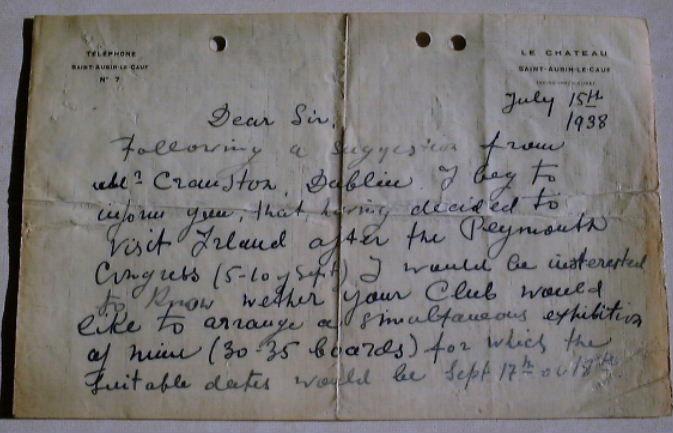

Hassan Roger Sadeghi (Lausanne, Switzerland) draws attention to a webpage which provides information about the château, ‘La Châtellenie à Dieppe’, together with a photograph.
Reference is made there to a past owner of the château having been ‘one of the most illustrious chessplayers’, and we note that, enticingly, the property can be rented for short periods. Readers will doubtless also wish to examine another webpage regarding the château.
From Jeffrey Tannenbaum (New York):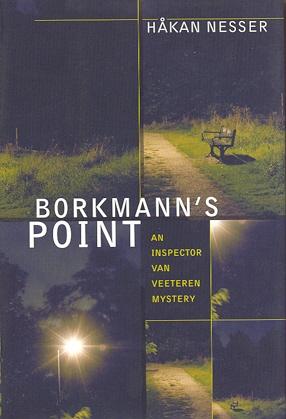
‘One of the latest fictional works to use and abuse chess is Borkmann’s Point, a murder mystery by Håkan Nesser. The book, translated into English by Laurie Thompson from the original Swedish, was published in the United States in 2006 by Pantheon Books, New York. The main character is Chief Inspector Van Veeteren, who becomes engaged in a series of chess games – both literal and metaphorical – with a police chief named Bausen. Both men love to play, and dislike it when moves spoil games. The following quote is from page 270:
“They had discussed this before and reached agreement on the matter: Games should be deep-frozen after the 35th or 50th move and never completed. (Such as Linkowski versus Queller in Paris, 1907. After the 42nd. Or Mikoyan versus Andersson, 1980 – in Brest, if he remembered rightly? After the 35th, or the 37th, at any rate.) Games in which the beauty of the situation was so great that any further move was bound to ruin it.”
Nesser thus conveys some of the delight in the game, although “Linkowski” and “Queller” are not actual names of players from the Paris, 1907 tournament, won by Antoniadi and Marshall, and “Mikoyan”, “Andersson” and the Brest event are also evidently fictional. While making up names and locations in a novel may not bother anybody, the author is annoyingly imprecise with some terminology. Van Veeteren says on page 105 that he did not play the Nimzo-Indian because “there’s more oomph in the Russian”, but which “Russian” defense is an option when the Nimzo-Indian is reachable? On the next page Van Veeteren laments that he can accept a loss as Black but that “when he had the white pieces and was able to use the Russian opening, there was no excuse”. On page 105 the author (or translator) also refers to rooks as “castles”, an old-fashioned word that few chessplayers would use today, and on page 270 he has one of the players asking if the other has prepared a “defense against the Sicilian”, as if the Sicilian were an attack by White. The detective does use some terms properly as metaphors, as when, on page 313, he describes a telephone call that he made to help find the killer as “an opening gambit”, which another character says was “more of an endgame”, since the solution to the case was imminent.’
C.N.s 3504 and 3511 did not mention Charles Platt’s involvement in correspondence chess, but we note on page 8 of the October 1910 Chess Amateur a reference to ‘Mr Chas. Platt, whose experience of correspondence play is perhaps greater than that of any player’.
Jerry Spinrad (Nashville, TN, USA) draws attention to the term Luftgreifer in the chess column of Round Table, 29 May 1869:
‘Some weeks ago we took occasion to caution our readers against falling into the habit of an unnecessarily tedious style of play, and we would now call their attention to another equally disagreeable custom, unfortunately too prevalent among modern chessplayers, namely the practice of hovering irresolutely with the hand over a piece or pawn before making the intended move. Who that has ever had the ill-luck to encounter a player addicted to this reprehensible practice can forget the tortures undergone when, after having made a move which he sees too late must prove fatal, his opponent’s hand commences to wander from one piece to another in a state of the most pitiable indecision; so that, should the dreaded coup at last be discovered, and checkmate given, the unfortunate loser feels such a sense of relief from the painful suspense under which he has been laboring as almost to make amends for the loss of the game. It is a pity that no rule exists by which some severe penalty might be enforced against the numerous body of Luftgreifer, or “air-graspers” as the Germans not inaptly style those chessplayers who have contracted this vice, as nothing short of some such penalty appears to have any effect on the peccant players.’
C.N. 4191 reproduced from CHESS a brief but sharp attack by George Koltanowski on a player named Blum, who he said was ‘once champion of France’. We have found no record of anyone of that name winning the French championship.
Koltanowski wrote more extensively about ‘Dr Karl Blum of Paris
(?)’ on pages 106-108 of With the Chess Masters (San
Francisco, 1972), again accusing him of financial impropriety,
and adding that Blum was imprisoned in Spain. ‘But after the
Madrid tournament of 1936, Dr Blum disappeared from the face of
the earth! Or seemed to. Some said he was in the ...’ etc., etc.
Koltanowski’s book (page 106) was demonstrably accurate on one matter: a player named Blum did win the championship of Paris in 1932. He came ahead of Rossolimo and Halberstadt (L’Echiquier, 28 January 1933, page 1944).
‘Not since Raoul Capablanca from Cuba has anyone from Latin or Central America generated so much excitement.’ So wrote Mark Tran on page 9 of The Guardian, 5 October 1991, in an article about a 12-year-old boy from El Salvador. ‘... At the legendary Manhattan Chess Club, where Bobby Fischer honed his game, grandmasters crowd around a phenomenon who is already compared to the American genius.’ The prodigy himself was quoted as follows: ‘If God wants, I will be champion at 20.’
The player in question was Jorge Zamora, known nowadays as Jorge Sammour Hasbun.
What facts are available about the table at the Café de la Régence which had allegedly been used by Napoleon Bonaparte? We are particularly interested in its current whereabouts. A photograph of the table, with Capablanca in friendly play against Aurbach, appeared on page 16 of The Times (London), 30 March 1922.
Our collection includes quite a few volumes carrying the bookplate of Albert Becker (1896-1984). It is reproduced below, from his copy of Tijdschrift van den Nederlandschen Schaakbond, 1929:
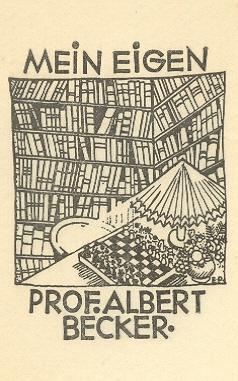
Gene Gnandt (Houston, TX, USA) raises the subject of the 1843 illustration of Staunton v Saint Amant, which has been widely published (e.g. as a supplement to the November 1911 issue of La Stratégie). Noting that a key was given on pages 325-326 of volume two of Geschichte und Litteratur des Schachspiels by A. van der Linde (Berlin, 1874), our correspondent has added numbers in the reproduction below:
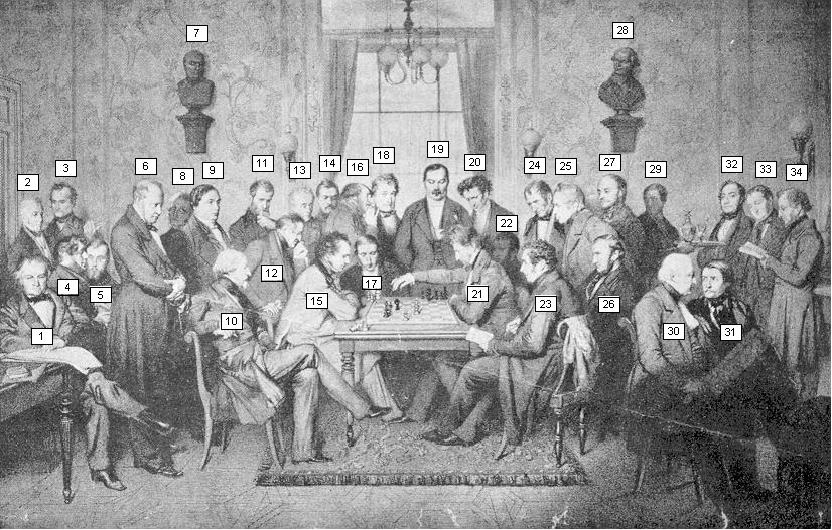
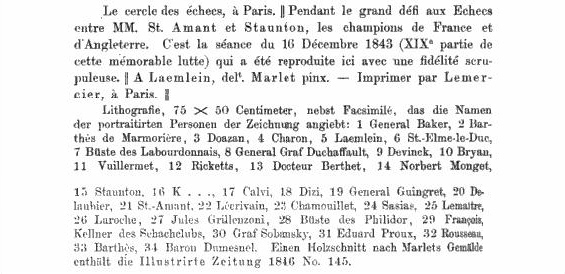
Mr Gnandt comments:
‘At least two of the figures are inconsistent with the key: “General Graf Duchaffault” (8) appears to the left of the “Büste des Labourdonnais” (7) while “Delaubier” (20) is clearly to the right of “St.-Amant” (21). These inconsistencies make me wonder about the correctness of the key as a whole. Can anyone confirm the identities of all the figures?’
We add that when the picture was given as the frontispiece to the February 1899 BCM ‘J.A.L.’ wrote on page 49 of that issue:
‘The original painting, after which the engraving was produced, is by Marlet, and in connection with it it is curious to note that its publication by the Palamède led to a lawsuit, in which St Amant was involved in his capacity of editor of that celebrated chess periodical. It appears that St Amant bought the painting of the artist for 500 francs, and handed it over to the engraver, Laemlein. The latter did not engrave from the original, but in the first instance made a copy of the painting, in which he substituted several well-known characters in the chess world for some of the persons in the original. As a consequence of these alterations, St Amant considered he was dealing with a fresh picture, and on publication he therefore only suffixed the name of the engraver. Thereupon Marlet brought an action against the Palamède for publishing his picture without his consent, and likewise for damages for the omission of his name. The first part of the action was dismissed, as it was held that the artist, in selling his picture, ceded all his rights to the purchaser. For the omission of his name he was awarded 200 francs damages, and St Amant was ordered to have Marlet’s name added to all future copies.’
Dominique Thimognier (St Cyr sur Loire, France) points out that whereas George Koltanowski referred to ‘Karl Blum’, a report on the 1932 Paris championship on page 230 of the October 1932 La Stratégie had ‘O. Blum’.
Mr Thimognier also sends the following advertisement for hotels frequented by leading chess masters. It appeared in several issues of the Bulletin de la FFE and its supplement L’Echo des échecs in 1934 and 1935:

Still on the subject of accommodation, the ‘Châtellenie’ in St Aubin-le-Cauf near Dieppe has rooms named after various chess pieces, as well as a ‘chambre Alekine’ [sic].
It may be recalled from C.N. 3747 that page 11 of the October 1947 CHESS had a letter written by Alekhine’s widow, ‘from Dieppe’.
In an article entitled ‘As I Saw Alekhine At Kemeri 1937’ on pages 252-254 of the May 1973 Chess Life & Review Paul Tamm described playing many casual games with Grace Alekhine:
‘... Mrs Alekhine was quite a good player and could easily compete in women’s tournaments. I was at that time a first-class player and still had trouble, when the two of us played without Alekhine present, gaining an edge of one or two points over Mrs Alekhine by the end of the day. I asked why she didn’t compete in women’s tournaments for the world title, and she replied simply that it probably wouldn’t be wise for two Alekhines to be aspiring for the world’s highest title. While answering this she was industriously knitting.’
From page 453 of the November 1933 BCM, in the course of a two-part article on Saint Amant by G.H. Diggle:
‘In Bell’s Life, 13 February 1853, Walker speaks of St Amant “at Hyères on the Mediterranean shore, engaged in literary labours respecting his late voyage to California”. From 1853-56 he wrote several books on the French Colonies which according to the Westminster Papers for December 1872 “were standard works on the subject”. In 1854 he also wrote a treatise on Les Vins de Bordeaux.’
In a footnote on the same page Diggle added:
‘The writer has ransacked France in vain for copies of these books. One was entitled La Guyane Française et ses mines d’or. Mr Adrian Horton of San Francisco informs me that another of St Amant’s books, Voyages en Californie et dans L’Oregon (Paris, 1854), is in the San Francisco Public Library. It contains 651 pages and is illustrated.’
Further information on any of these books will be welcomed.
Juan Carlos Sanz Menéndez (Madrid) asks about coins with a chess motif and draws attention to the following:

C.N.s 3159 and 3170 (see pages 279-280 of Chess Facts and Fables) discussed a famous Tal victory (1 e4 c5 2 Nf3 d6 3 d4 cxd4 4 Nxd4 Nf6 5 Nc3 g6 6 Be3 Bg7 7 f3 Nc6 8 Qd2 Bd7 9 O-O-O Rc8 10 Kb1 Qa5 11 g4 h6 12 h4 a6 13 Be2 Ne5 14 g5 hxg5 15 hxg5 Rxh1 16 gxf6 Rxd1+ 17 Nxd1 Qxd2 18 fxg7 e6 19 g8(Q)+ Ke7 20 Qxc8 Resigns), noting that secondary sources have given it various dates from 1958 to as late as 1970.
On pages 41-42 of the March 2006 CHESS it was pointed out that the conclusion to the game was on page 166 of The Chess Psychologist World Champion Tal by A. Liepnieks (published by the North American Latvian Chess Association in 1961), and that the full score was included in the Tal volume in the Weltgeschichte des Schachs series, brought out the same year. Both books had ‘N.N.’ as Tal’s opponent, both stated that the venue was Stuttgart, and the latter work (in which Tal himself was involved) had the date 1958. CHESS also mentioned that the game was given in ‘the Russian bulletin Interzonal Tournament and 13th Olympiad, No. 20, 19 November 1958’, and that the 5 November 1958 issue of Schach Echo recorded Tal’s score in a simultaneous display in Stuttgart as +38 – 6 =1.
Our previous C.N. items noted that some sources identify Black as ‘Feuerstein’ and that a Cuban book put ‘Shmith’ [sic]. Could a reader with access to the Stuttgart newspapers of the time kindly check whether the Tal game appeared there and, if so, whether Black was named?
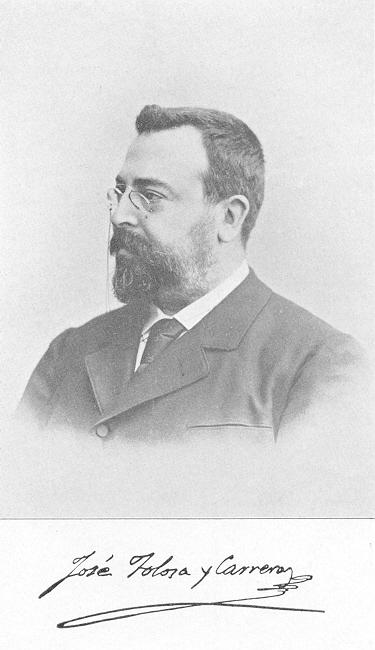
This photograph is of José Tolosa y Carreras (1846-1916) and appeared in the 7 April 1907 issue of Deutsches Wochenschach.
The obituary of Hans Kmoch by Burt Hochberg on pages 211-212 of the April 1973 Chess Life & Review included the following information:
‘He and Tartakower (who was a published poet in three languages in addition to being a great player and theorist) epitomized a new departure in chess writing – theoretical erudition combined with high literary standards and the minimizing of egocentricity. It is to be remembered that before Kmoch became professionally involved in chess he was a Latin scholar and editor of a literary magazine.’
What is known about Kmoch’s non-chess literary activities?
C.N.s 2809, 3263 and 3277 (see pages 1-2 of Chess Facts and Fables) discussed George H. Derrickson, and two problems composed by him were gleaned from The Clipper Chess Problem Tournament by Miron J. Hazeltine (New York, 1860). The first of these, however, was given by us with a white pawn on f2, instead of g2, as Elmer Sangalang (Manila, the Philippines) has pointed out to us. Below is the correct diagram of the mate in six:

Dan Scoones (Victoria, BC, Canada) reports that Saint Amant’s book La Guyane Française et ses mines d’or can be read online through the Google Books Library Project website.
Christian Sánchez (Rosario, Argentina) notes that for the skewer motif Milton L. Hanauer used the term ‘hurdle’; see, for instance, page 56 of Hanauer’s book Chess Made Simple (New York, 1957).
Our correspondent also mentions that the Spanish translator of B.H. Wood’s Easy Guide to Chess had difficulty in finding an equivalent for ‘skewer’, as explained in a footnote on page 66 of Camino fácil del ajedrez (Buenos Aires, 1944):
‘Este tipo de elemento de combinación es una mezcla de “doble” y “clavada”, con preferencia lo primero, y su clasificación por separado creemos es la primera vez que se efectúa. Hemos adoptado el vocablo original inglés, pues es difícil hallar un término tan expresivo en el idioma castellano, ya que la traducción literal de “skewer” (espetador, o aguja de ensartar) no suena muy bien, y hasta que sea propuesto algún vocablo equivalente y práctico, como sucede con varias expresiones del diccionario ajedrecístico.’

White won with 1 Rh8+ Kf7 2 Be8+ Nxe8 3 Kg5 and 4 Rf8.
This position from a game between Bondarevsky and Ufimtsev was discussed in C.N.s 2989 and 2995 (see pages 8-9 of Chess Facts and Fables), and in the latter item our correspondent Christian Sánchez deduced that it was played in Leningrad in 1936. He now remarks that the game ending was position 21 in Bondarevsky’s book on middlegame combinations (e.g. page 30 of the Russian edition published in Moscow in 1965) and that Bondarevsky explicitly stated there that the game had indeed been played in Leningrad in 1936.

Who is this? Only one clue is supplied: he lost a famous game.
Chess Notes Archives:
| First column | << previous | Archives [20] | next >> | Current column |
Copyright 2006 Edward Winter. All rights reserved.